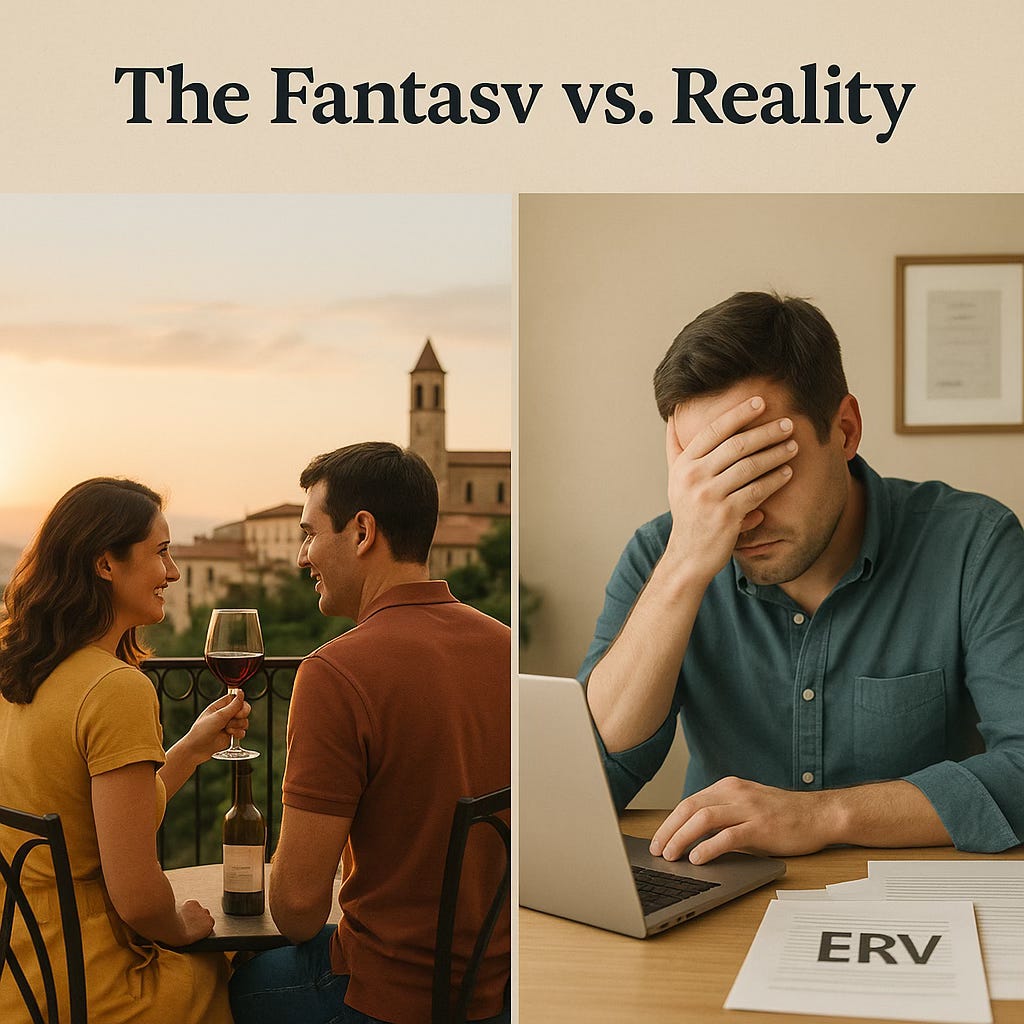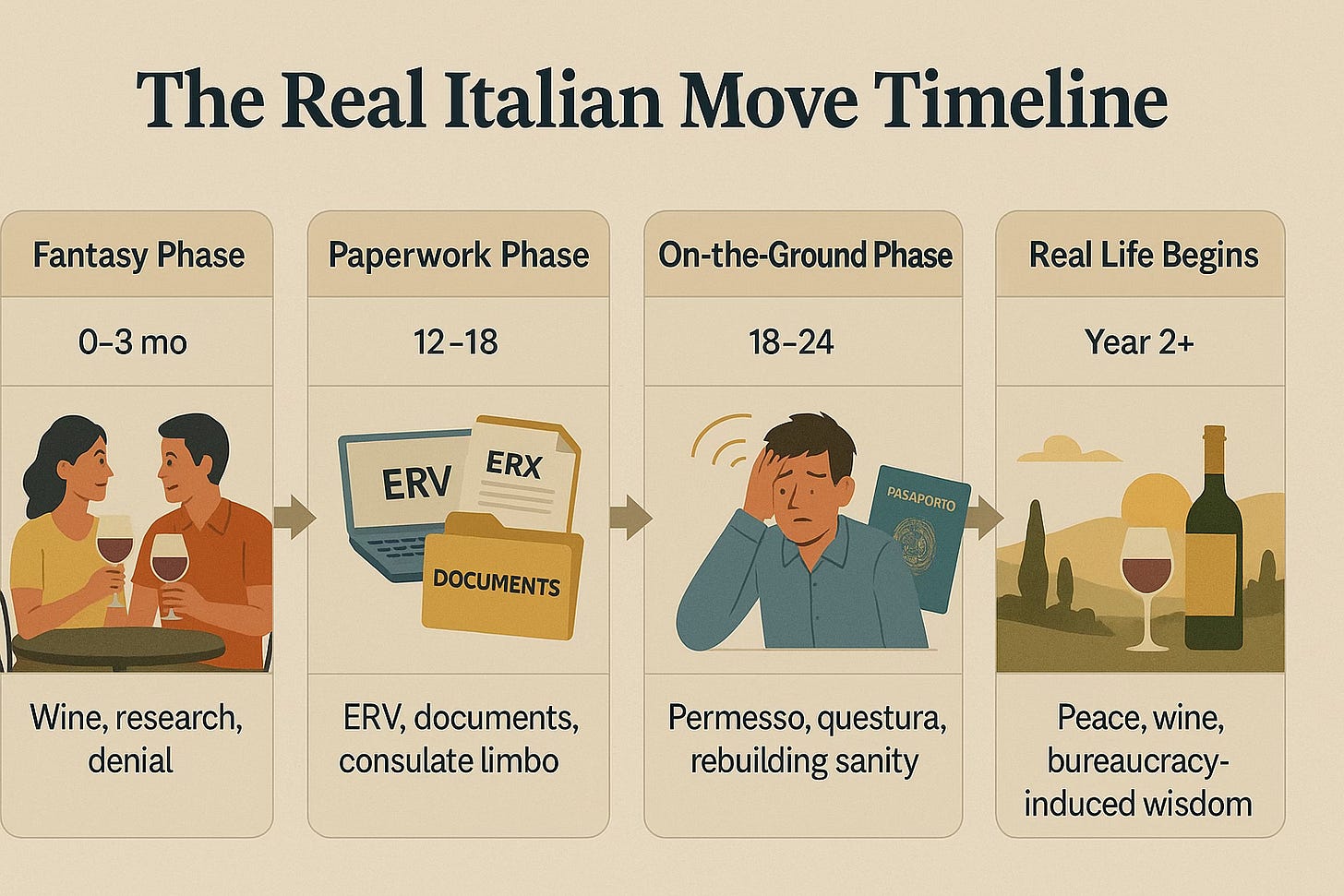How Long it Really Takes to Move to Italy?
Forget the fantasy. Here's a real timeline, real delays, and why it's still 100% worth it.
Everyone loves a good Italian escape fantasy. You sell the house, pack a few suitcases, hop on a plane, and within weeks you’re sipping espresso on a terrace somewhere between the hills of Umbria and the Ligurian coast. That’s the daydream, anyway. The reality? It’s a bit more... bureaucratic.
What no one tells you early on — at least not in any of the Instagram posts or influencer reels — is that moving to Italy takes time. Not just logistical time. *Existential* time. The kind that bends your sense of urgency, stretches your expectations, and slowly trains you to recalibrate what "progress" actually looks like.
For most people, this starts innocently enough. You watch a documentary about truffle hunting, or you visit Rome and have a moment on a quiet side street that makes you question why you’ve been living in traffic for two decades. You go home, pour a glass of wine, and start Googling “how to move to Italy.”
This is what I call the fantasy phase. You’re full of energy, scribbling towns on napkins, watching YouTube videos of people who bought €1 houses and made it work. Maybe you even join a few Facebook groups — the ones with names like "La Dolce Vita Abroad" or "Expats Who Found Themselves." Everything feels possible.
But a few months in, the wheels start to come off.
You learn about the Elective Residency Visa (ERV), and suddenly it’s not so simple. You need to show a certain amount of passive income. You need health insurance, a rental contract, a translated-and-apostilled birth certificate, a letter from your bank, maybe even a note from your doctor depending on the consulate. You also learn that different Italian consulates in the U.S. handle the process differently. Some take months to reply. Some go silent entirely.
This is the moment when the fantasy gives way to frustration. And that frustration can last a long time. Months, in fact. I know people who’ve taken a full year just to gather the paperwork and find a consulate willing to issue the visa.
Then comes the visa submission itself. This part feels oddly anticlimactic. You’ve spent months preparing your file, tracking down obscure forms, and translating documents into Italian — and then it’s out of your hands. You wait. Sometimes for 60 days. Sometimes for 120. You refresh your inbox like it owes you something.
And then one day — usually when you’ve nearly given up — it arrives. The visa. A sticker in your passport. Proof that the machine said yes.
But this is only the halfway point.
You arrive in Italy and the next chapter begins: registering your residency, applying for your permesso di soggiorno, dealing with the local comune and questura, deciphering handwritten signs taped to locked doors, learning when government offices are actually open versus when they say they’re open. It’s not hard, exactly. But it’s relentless. Death by a thousand forms.
Most people underestimate this phase. They assume once they have the visa, it’s smooth sailing. But the truth is, the Italian bureaucracy doesn't loosen its grip — it just changes form. The process of converting your visa into a residence permit, and eventually obtaining things like your Carta d’Identità or Tessera Sanitaria, can take another year. Sometimes longer.
And yet — here’s the thing — most people who make it through this gauntlet say the same thing: I’d do it all again.
Because there’s something oddly satisfying about earning your place. About learning to navigate a new system. About discovering that you’re capable of patience you didn’t know you had. Italy doesn’t reward speed — it rewards persistence.
Why This Feels So Hard
Because no one’s mapped it out — not really. There’s no clean timeline, no universal checklist, no “Step 1: Move to Tuscany, Step 2: Be Happy.” You’re left guessing what’s normal, what’s a red flag, and whether you’ve already screwed something up just by asking the wrong consulate the right question.
You start to wonder: Am I the problem? You’re not.
Italy just runs on a different tempo — part jazz, part opera, part Kafka. It will test your patience. It will confuse you. And it absolutely does not apologize.
But here’s the truth: if you give yourself the space to plan before you’re desperate… if you stop trying to force an American timeline onto an Italian process… if you expect the delays, the missteps, the circling back — you’ll be fine. Not fast, but fine. And maybe, just maybe, better for it.
My Rule of Thumb:
Give yourself at least 24 months from “I want to move” to “I have my permesso di soggiorno.” That’s not a scare tactic — that’s just the tempo. If you manage to do it faster, fantastic. If it takes longer, you’re still not failing.
What matters is that you plan for real, not for ideal.
And once you get through it — the paperwork, the consulate dead-ends, the mysterious delays, the endless waiting rooms — you’ll realize something kind of profound: you earned it.
You didn’t shortcut the system. You didn’t just show up and expect to be handed la dolce vita. You built it. Slowly, deliberately, stubbornly.
And when you’re finally watching the sunset from your own terrace, with legal residency in your pocket, glass of wine in hand, and nothing but Italian air in your lungs?
The DMV line will feel like a fever dream. You’ll be right where you’re supposed to be. And it’ll be worth every single maddening step.
If you want a full breakdown of what to expect, with actual timelines, paperwork guides, and strategies for avoiding the most common mistakes, that’s exactly why I wrote “Escape Plan: How to Move from the U.S. to Italy Without Losing Your Mind or Money”. It’s not a memoir. It’s a map.
And if you’re not ready for the book but still want the free planning tools — including a consulate-tested ERV checklist and a database of 7% tax towns — head over here:
Start now. Go slow. And when the system breaks your spirit for the third time — take a deep breath, pour a glass of Barbera, and remember why you started.
Italy is worth it.




